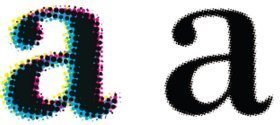With offset printing, there are inevitably variations of 2 to 3 tenths of a millimeter for every elements printed. For large and medium-sized elements, this change will go unnoticed. But for smaller items as well as fine lines and text with a size smaller than 8 points, the difference might become more visible and lead to loss of readability and blurriness.
To avoid any complications, we recommend that you avoid using more than 2 colors for the composition of small elements.
For example, look at the following letter (enlarged):

Composing it using 4 colors can seriously undermine the readability of the text, while only one color does not influence reading quality.
For fine lines (with a thickness inferior to 2 points), the same logic applies. Let’s say you want to print a brown line. Three colors are necessary to make up brown: cyan, magenta, and yellow.
Consequently, an error may occur with printing if the line is thin:
When the line is thinner than 2 points, your line may end up with five different colors instead of just one (as desired).
To avoid this, these small elements should be formed by not more than two colors. If not possible, their size should be increased to a more appropriate size that does not cause the aforementioned problems.
In our example, the line should have been either in one color (e.g. black) if it was thin, or at least 3-4 points thick if it was in more than 2 colors.


















